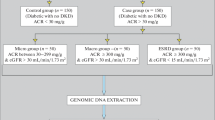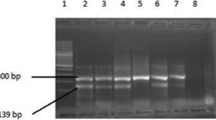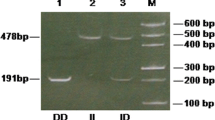Abstract
The aim of present study was to determine if factor V Leiden (FVL) mutation and angiotensin converting enzyme insertion/deletion (ACE I/D) polymorphism are associated with diabetic nephropathy (DN) among Kurdish population from Western Iran. This case–control study comprised 144 unrelated adult type 2 diabetic mellitus patients (T2DM) including 72 patients with microalbuminuria and 72 age and sex matched patients without nephropathy. The ACE I/D polymorphism and FVL mutation were detected by polymerase chain reaction (PCR) and PCR–RFLP, respectively. The frequency of FVL G1691A and ACE D allele in T2DM patients with microalbuminuria were 1.6 and 57%, respectively and in normoalbuminuric T2DM patients were 4.9 and 58.3%, respectively (P > 0.05). ACE genotypes affected on serum ACE activity and a better response to ACE inhibitor therapy (captopril) compared to angiotensin II receptor antagonist (losartan) was obtained with significant reduction of ACE activity in diabetic patients without nephropathy carrying DD genotype. However, the beneficial effect of losartan therapy was observed in microalbuminuric patients with II genotype compared to ID and DD genotypes.
Similar content being viewed by others
References
Vaisi-Raygani A, Rahimi Z, Nomani H, Tavilani H, Pourmotabbed T (2007) The presence of apolipoprotein ε4 and ε2 alleles augments the risk of coronary artery disease in type 2 diabetic patients. Clin Biochem 40:1150–1156
Kotani K, Fujiwara S, Tsuzaki K et al (2009) An association between angiotensin II type 2 receptor gene A/C3123 polymorphism and glycemic control marker in a general Japanese population. Mol Biol Rep 36:917–920
Movva S, Alluri RV, Komandur S et al (2007) Relationship of angiotensin-converting enzyme gene polymorphism with nephropathy associated with type 2 diabetes mellitus in Asian Indians. J Diabetes Complications 21:237–241
Arfa I, Abid A, Nouira S et al (2008) Lack of association between the angiotensin-converting enzyme gene (I/D) polymorphism and diabetic nephropathy in Tunisian type 2 diabetic patients. J Renin Angiotensin Aldosterone Syst 9:32–36
Glenn KL, Du ZO, Eisenmann JC, Rothschild MF (2009) An alternative method for genotyping of the ACE I/D polymorphism. Mol Biol Rep 36:1305–1310
Azarpira N, Bagheri M, Raisjalali G et al (2009) Angiotensinogen, angiotensine converting enzyme and plasminogen activator inhibitor-1 gene polymorphism in chronic allograft dysfunction. Mol Biol Rep 36:909–915
Ruggenenti P, Bettinaglio P, Pinares F, Remuzzi G (2008) Angiotensin converting enzyme insertion/deletion polymorphism and renoprotection in diabetic and nondiabetic nephropathies. Clin J Am Soc Nephrol 3:1511–1525
Palomo-Pinon S, Gutierrez-Rodrigues ME, Diaz-Flores M et al (2009) DD genotype of angiotensin-converting enzyme in type 2 diabetes mellitus with renal disease in Mexican Mestizos. Nephrology 14:235–239
Akin F, Turgut S, Dursunoglu D, Turgut G, Karasu U, Gur S (2009) ACE gene polymorphism and cardiac structure in patients with insulin resistance. Mol Biol Rep 36:623–629
Mozafari H, Rahimi Z, Heidarpour A, Fallahi M, Muniz A (2009) The prevalence of factor V Leiden, prothrombin G20210A and methylenetetrahydrofolate reductase C677T among G6PD deficient individuals from Western Iran. Mol Biol Rep 36:2361–2364
Akman B, Afsar B, Ataç FB et al (2006) Predictors of vascular access thrombosis among patients on the cadaveric renal transplantation waiting list. Transpl Proceed 38:413–415
Rahimi Z, Vaisi-Raygani A, Mozafari H, Kharrazi H, Rezaei M, Nagel RL (2008) Prevalence of factor V Leiden (G1691A) and prothrombin (G20210A) among Kurdish population from Western Iran. J Thromb Thrombolysis 25:280–283
Rahimi Z, Mozafari H, Shariari-Ahmadi A et al (2010) Deep venous thrombosis and thrombophilic mutations in Western Iran: association with factor V Leiden. Blood Coagul Fibrinolysis 21:385–388
Rahimi Z, Mozafari H, Amiri Bigvand AH et al (2010) Cerebral venous and sinus thrombosis and thrombophilic mutations in Western Iran: association with factor V Leiden. Clin Appl Thromb Hemost 16:430–434
Rahimi Z, Vaisi-Raygani A, Pourmotabbed T (2010) Association between apolipoprotein ε4 allele, factor V Leiden, and plasma lipid and lipoprotein levels with sickle cell disease in Southern Iran. Mol Biol Rep. doi:10.1007/s11033-010-0157-4
Azimi-Nezhad M, Ghayour-Mobarhan M, Parizadeh MR et al (2008) Prevalence of type 2 diabetes mellitus in Iran and its relationship with gender, urbanization, education, marital status and occupation. Singapore Med J 49:571–576
Rahimi Z, Akramipour R, Nagel RL, Ahmadi AS, Merat A, Bahrehmand F (2006) The beta-globin gene haplotypes associated with Hb D-Los Angeles [beta121(GH4)Glu → Gln] in Western Iran. Hemoglobin 30:39–44
Nikzamir A, Nakhjavani M, Esteghamati A, Rashidi A (2008) Correlates of ACE activity in macroalbuminuric type 2 diabetic patients treated with chronic ACE inhibition. Nephrol Dial Transplant 23:1274–1277
Nikzamir A, Esteghamati A, Feghhi M, Nakhiavani M, Rashidi A, Reza JZ (2009) The insertion/deletion polymorphism of the angiotensin-converting enzyme gene is associated with progression, but not development, of albuminuria in Iranian patients with type 2 diabetes. J Renin Angiotensin Aldosterone Syst 10:109–114
WHO Study Group Report of a WHO consultation (1999) Part 1: diagnosis and classification of diabetes mellitus. World Health Organization, Geneva
American Diabetes Association (2004) Nephropathy in diabetes. Diabetes Care 27:S79–S83
Old JM, Higgs DR (1983) Gene analysis. In: Weatherall DJ (ed) Methods in hemotology, vol. 6. The thalassemias. Livingstone, UK, pp 74–101
Nakhjavani M, Esfahnian F, Jahanshahi A et al (2007) The relationship between the insertion/deletion polymorphism of the ACE gene and hypertension in Iranian patients with type 2 diabetes. Nephrol Dial Transplant 22:2549–2553
Maguire GA, Price CP (1985) A continuous monitoring spectrophotometric method for the measurement of angiotensin-converting enzyme in human serum. Ann Clin Biochem 22:204–210
Ng DPK, Tai BC, Koh D, Tan KW, Chia KS (2005) Angiotensin-I converting enzyme insertion/deletion polymorphism and its association with diabetic nephropathy: a meta-analysis of studies reported between 1994 and 2004 and comprising 14727 subjects. Diabetologica 14:1008–1016
Hadjadj S, Fumeron F, Roussel R et al (2008) Prognostic value of the insertion/deletion polymorphism of the ACE gene in type 2 diabetic subjects. Diabetes Care 31:1847–1852
Eroglu Z, Cetinkalp S, Erdogan M (2008) Association of the angiotensinogen M235T and angiotensin-converting enzyme insertion/deletion gene polymorphism in Turkish type 2 diabetic patients with and without nephropathy. J Diabetes Complications 22:186–190
Zhou JB, Yang JK, Lu JK, An YH (2010) Angiotensin-converting gene polymorphism is associated with type 2 diabetes: a meta-analysis. Mol Biol Rep 37:67–73
Kalaitzidis R, Bakris GL (2009) Effects of angiotensin II receptor blockers on diabetic nephropathy. J Hypertension 27(Suppl 5):S15–S21
So WY, Ma RC, Ozaki R et al (2006) Angiotensin-converting enzyme (ACE) inhibition in type 2 diabetic patients: Interaction with ACE insertion/deletion polymorphism. Kidney Int 69:1438–1443
Ha SK, Yong Lee S, Su Park H et al (2000) ACE DD genotype is more susceptible than ACE II and ID genotypes to the antiproteinuric effect of ACE inhibitors in patients with proteinuric non-insulin-dependent diabetes mellitus. Nephrol Dial Transplant 15:1617–1623
Kfoury E, Taher A, Saghieh S, Otrock ZK, Mahfouz R (2009) The impact of inherited thrombophilia on surgery: a factor to consider before transplantation? Mol Biol Rep 36:1041–1051
Rahimi Z, Nomani H, Mozafari H et al (2009) Factor V G1691A, prothrombin G20210A and methylenetetrahydrofolate reductase C677T polymorphism are not associated with coronary artery disease and type 2 diabetes mellitus in Western Iran. Blood Coagul Fibrinolysis 20:252–256
Author information
Authors and Affiliations
Corresponding author
Rights and permissions
About this article
Cite this article
Rahimi, Z., Felehgari, V., Rahimi, M. et al. The frequency of factor V Leiden mutation, ACE gene polymorphism, serum ACE activity and response to ACE inhibitor and angiotensin II receptor antagonist drugs in Iranians type II diabetic patients with microalbuminuria. Mol Biol Rep 38, 2117–2123 (2011). https://doi.org/10.1007/s11033-010-0338-1
Received:
Accepted:
Published:
Issue Date:
DOI: https://doi.org/10.1007/s11033-010-0338-1




